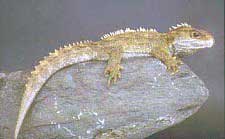
Dimdima
Online Children's Magazine from India

Dimdima
Online Children's Magazine from India

Although the tuatara is very much like a lizard in external appearances, it belongs to a separate group of reptiles, the Rhynchocephalia. From fossil remains we know that rhynchocephalians were in existence over 200 million years ago, & that they occurred in the past in Europe, Asia, North & South America & South & East Africa. However, it appears that they have been extinct everywhere except in New Zealand for about 60 million years.
The tuatara is almost identical in structure with Homoeosaurus, a form known from Upper Jurassic deposits of Europe (about 140 million years ago). The tuatara is known as a ‘living fossil’. The tuatara is closely related to the ancestors of modern lizards, so it is not surprising that it can easily be mistaken for a lizard.
The Maori word tuatara means ‘peaks on the back’, & refers to the triangular folds of skin which form a conspicuous crest along the middle of the back of the male, & a rudimentary crest on the female. The spines are normally soft & pliant, but can be stiffened when the animal is alarmed, making it look very fierce & aggressive.
The tuatara probably arrived in NZ while the country was still attached to a larger land mass- most likely they came overland from South America via Antarctica, while the southern continents formed one large land mass known as Gondwanaland.
The tuatara has no earhole, & the male has no copulatory organ; it has ‘uncinate processes’ on some of the ribs, has complete bars of bone on all sides of 2 large apertures on each side of the skull; & develops a caruncle, or ‘egg-breaker’ to permit the young to escape from the egg. The teeth are set squarely on the surface of the jawbone, & tightly fused with it- a form of attachment known as ‘acrodont’. There is a clear distinction between males & females; males can reach a length of 610mm & a weight of 1,000g but females are shorter, & a good deal lighter with a smaller, narrower head than the male. In colour, they are basically olive-green, though dark pink, or slate grey individuals are often seen. The males have a white blotch below the ear region. The tuatara is probably one of the longest living & slowest growing reptiles in existence.
The tuatara has the ability to shed a portion of its tail as a means of self defence against predators, or attacks by others of its own kind.
Dimdima is the Sanskrit word for ‘drumbeat’. In olden days, victory in battle was heralded by the beat of drums or any important news to be conveyed to the people used to be accompanied with drumbeats.
Bharatiya Vidya Bhavan
K. M Munshi Marg,
Chowpatty, Mumbai - 400 007
email : editor@dimdima.com
Bharatiya Vidya Bhavan
505, Sane Guruji Marg,
Tardeo, Mumbai - 400 034
email : promo@dimdima.com
Dimdima.com, the Children's Website of Bharatiya Vidya Bhavan launched in 2000 and came out with a Printed version of Dimdima Magazine in 2004. At present the Printed Version have more than 35,000 subscribers from India and Abroad.